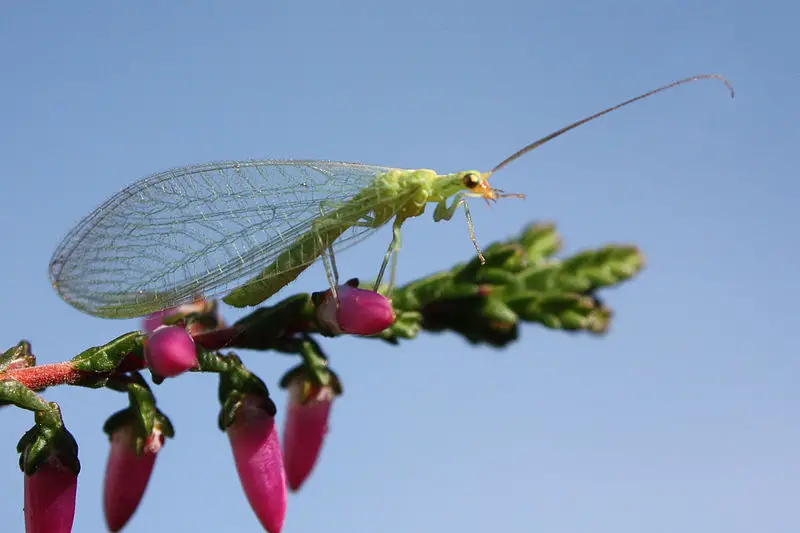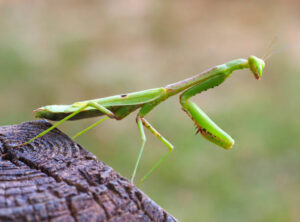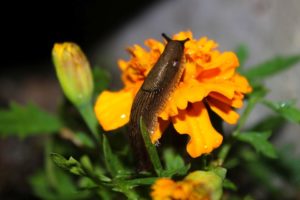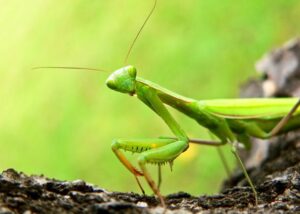Green lacewings are beneficial insects that help control problematic pests in the garden and greenhouse. They measure approximately 1/2 to 3/4 inches in length (1 to 1.9 cm) and have long, translucent, lace-like wings (hence the name) that extend well beyond their bodies. Their long antennae and gold or copper-colored eyes add to their unique appearance. While there are a number of different species, they all bear a similar appearance.
Gardeners are generally less enthused with green lacewings, which often take a backseat to the popular ladybug, another beneficial insect. But these tiny green garden helpers deserve a second look.
Where to Find Green Lacewings
Green lacewings can be found in a wide variety of vegetation including grassy areas, shrubs, garden plants, and weeds. They are primarily nocturnal, emerging from their hiding places as the sun sets, but can also occasionally be found roaming during daylight hours. Sightings of these fragile-looking insects often occurs under porch lights at night as they, like many insects, are drawn to the light.
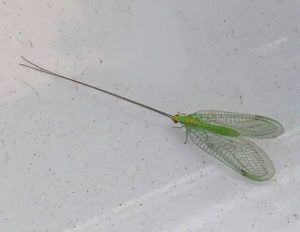
Green Lacewing Lifecycle
The lifespan of an adult green lacewing is about forty days. They feed on pollen, nectar, and honeydew, which is a sticky substance excreted by aphids. They sometimes produce a foul smell when handled.
Lacewings mate during the early stage of adulthood. The female lacewing will lay her eggs by touching the tip of her abdomen against the underside of a leaf, branch, or other surface and then pull away. The movement creates a 1/4 inch long, fine, thread-like filament that hardens immediately. She will then lay an egg on the top of each filament. After a period of three to ten days, larvae measuring 1/2 inch (1 cm) will emerge. They have flat, elongated bodies that vary in color from gray to yellow, to brown and are sometimes confused with the darker colored ladybug larvae. Once hatched, the larvae will immediately begin searching for food. Soft-bodied insects like leafhopper nymphs, aphids, thrips, spider mites, small caterpillars like cabbage worms, whiteflies, mealybugs, and insect eggs are prime targets. After two to three weeks, the larva will spin a cocoon and 10 to 14 days later, an adult green lacewing will emerge.
While lacewing larvae feed on a wide variety of insects, as noted, they have earned the moniker aphid lions because of their insatiable appetite for the sap-sucking insects. The lacewing larva will take hold of an aphid using its grooved, caliper-shaped jaws, often lifting it in the air so it can drink the fluids from the aphid’s body. According to the Missouri Department of Conservation, one larva can eat an aphid a minute, for hours on end.[1] Thus, the larval stage is the most beneficial stage of development because of the biological pest control it offers.
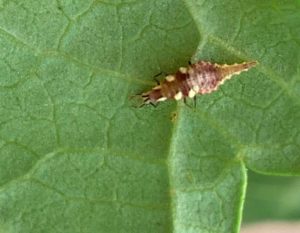
How to Attract Lacewings
The best way to attract green lacewings to your garden is to provide them with the food sources they prefer. Plants that produce nectar and pollen are favorites of adult lacewings.
Some recommend waiting to treat a light aphid outbreak as a way to entice lacewings to your garden. What’s more, some recommend lightly spraying a mixture of 1 cup of water and 1 tablespoon of sugar on plants to help attract the lacewings to the aphids.[2] The mixture mimics honeydew which lacewings eat.
This article contains affiliate links. If you make a purchase using one of these links, I will receive a very small commission at no additional cost to you, and it will help me maintain this website. Rest assured, I only recommend products I actually like!
Row covers, while very beneficial in protecting plants from harmful insects, can also be impede beneficial insects like green lacewings and ladybugs. Removing the row covers after dusk when lacewings begin to feed will give them access to the pollen and nectar and provide them a place to lay their eggs.
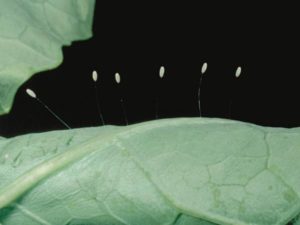
Be sure to turn off bug zappers as adult lacewings are attracted to the light. Also, suspend the use of any pesticides or insecticides, at least temporarily, as they will potentially kill the beneficial insects you are trying to attract.
If you are unable to attract lacewings or simply want to try to increase the population in your garden or greenhouse, consider ordering them online. As with any beneficial insect, lacewing larvae and adults will leave your garden if they do not find an adequate source of food. It is important not to release parasitic wasps at the same time because they will lay eggs on lacewing cocoons, and once hatched, the wasp larvae will eat the lacewing larvae.
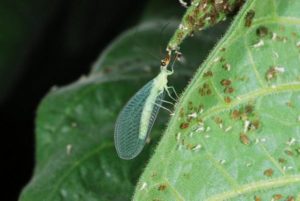
Green lacewings are fascinating beneficial insects that can play an important role in the safe biological control of harmful, soft-bodied pests. They may not be as adorable as ladybugs, but they can definitely do the job.
Thank you for reading this article! If you found it helpful, please consider sharing it with others via email or social media!
[1] Green Lacewings, The Missouri Department of Conservation, accessed 4-14-21, https://nature.mdc.mo.gov/discover-nature/field-guide/green-lacewings
[2] Barbara Pleasant, About Lacewing Flies: How to Attract Lacewings to Your Garden, Mother Earth News, accessed 4-14-21, https://www.motherearthnews.com/organic-gardening/pest-control/lacewing-flies-attract-lacewings-zw0z1302zkin
